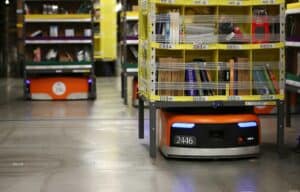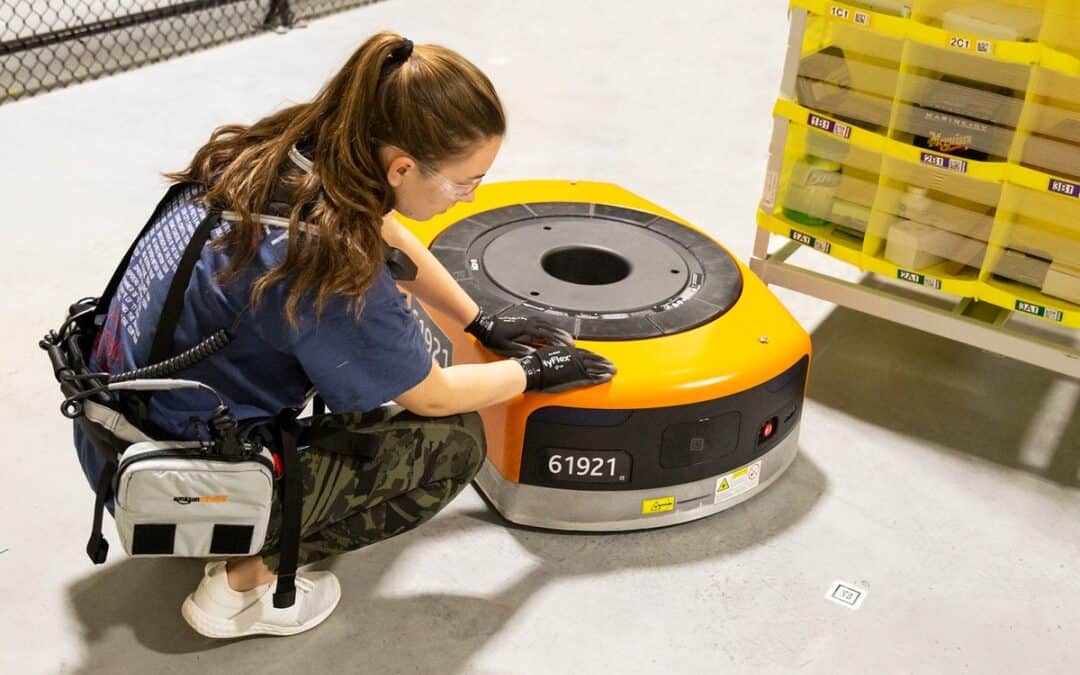Recently Amazon has put its new robot, dubbed “Scout” to work, it’s a six-wheeled delivery device that has begun delivering to customers in Southern Californian suburbs, Scout is still accompanied by amazon personnel, as it’s still in its infant stages. The plan is to eventually have scout be fully independent. With robots already starting to deliver goods, how long before we have a fully automated warehousing system?
 Currently technology limits robotics in the workforce to be proficient at only extremely repeatable and specific tasks, to program a robot to learn a new task is a very time consuming and expensive, even the task of simply identifying and picking something up without training requires advanced hardware and software that isn’t readily available for commercial use. Amazon is currently leading the race to fully automated warehouses, yet claims that humans are a necessity due to the large limitations imposed on robotics, Scott Anderson, Amazons director of robotics stated “the point at which an Amazon warehouse is fully, end-to-end automated is at least 10 years away”.
Currently technology limits robotics in the workforce to be proficient at only extremely repeatable and specific tasks, to program a robot to learn a new task is a very time consuming and expensive, even the task of simply identifying and picking something up without training requires advanced hardware and software that isn’t readily available for commercial use. Amazon is currently leading the race to fully automated warehouses, yet claims that humans are a necessity due to the large limitations imposed on robotics, Scott Anderson, Amazons director of robotics stated “the point at which an Amazon warehouse is fully, end-to-end automated is at least 10 years away”.
 However, it’s a case of humans and robots, not humans vs. robots. Amazon currently has 175 fulfillment centres worldwide. 26 of them have people and robots working together as a team, to sort, transport, pick and stow packages. Although some can argue this automation has taken over some jobs such as carrying inventory or pallet transportation, it’s also improving human efficiency, as humans don’t do the less desirable and tedious tasks. Currently 100,000 robots “work” for Amazon, they aid humans by enabling them to lift and walk less, by moving items around the warehouse. But humans are still needed for tasks where a high amount of judgment is required. Robotic aid has enabled Amazon to store 40% more inventory, helping streamline their supply chain and improve the customer experience.
However, it’s a case of humans and robots, not humans vs. robots. Amazon currently has 175 fulfillment centres worldwide. 26 of them have people and robots working together as a team, to sort, transport, pick and stow packages. Although some can argue this automation has taken over some jobs such as carrying inventory or pallet transportation, it’s also improving human efficiency, as humans don’t do the less desirable and tedious tasks. Currently 100,000 robots “work” for Amazon, they aid humans by enabling them to lift and walk less, by moving items around the warehouse. But humans are still needed for tasks where a high amount of judgment is required. Robotic aid has enabled Amazon to store 40% more inventory, helping streamline their supply chain and improve the customer experience.
But what happens when humans are no longer needed? Although some of the more basic warehousing jobs may be phased out in the future, since the robotics program at Amazon commenced in 2012, more than 310,000 full time jobs have been added globally, from R&D and IT, to the maintenance and servicing of robots. Currently warehouses with robotic aid actually require more humans as inventory is moved at a higher rate. Amazon also employs approximately 570,000 people worldwide.
Although some may have negative connotations associated towards robots thanks to Hollywood or by being misinformed, teaming up with robots is the future of the workforce for a streamlined supply chain and improved customer experience.

